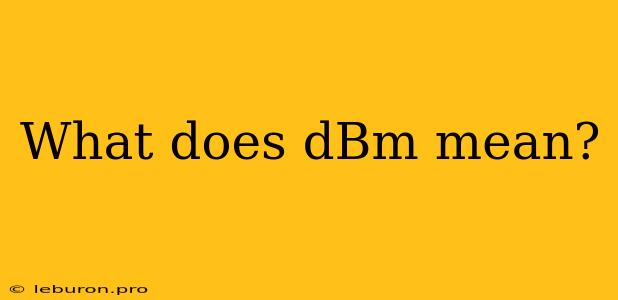dBm is a unit of measurement used to express power levels, particularly in the field of telecommunications and signal strength. It stands for "decibel-milliwatts," and it represents a logarithmic expression of power relative to one milliwatt (mW). Understanding dBm is essential for professionals working with wireless signals, radio frequency (RF) systems, and other areas where power measurements are crucial. This article will delve into the concept of dBm, explaining its significance, how it is calculated, and its applications.
Understanding dBm: A Logarithmic Scale for Power
The decibel (dB) is a logarithmic unit that simplifies the expression of large power ratios. dBm, specifically, relates power levels to a reference point of 1 mW. This logarithmic scale makes it easier to express and compare power values over a wide range, which is particularly useful when dealing with the vast power variations encountered in RF systems.
Why Use dBm?
There are several reasons why dBm is preferred over the direct use of milliwatts (mW):
- Convenience: dBm provides a more compact way to express power levels, especially when dealing with large values. For example, 100 mW can be expressed as 20 dBm, which is more concise.
- Logarithmic Scale: The logarithmic nature of dBm makes it easier to handle large variations in power. A 3 dBm difference represents a doubling of power, while a 10 dBm difference corresponds to a tenfold increase in power. This logarithmic scale is more intuitive for understanding power ratios.
- Signal Strength Comparison: In wireless communication, dBm is widely used to express signal strength. Using dBm allows for straightforward comparisons of signal strengths from different sources or at different points in a network.
How to Calculate dBm
The conversion between dBm and mW is given by the following formula:
dBm = 10 * log10(Power in mW / 1 mW)
Conversely, to convert from dBm to mW, we use:
Power in mW = 10^(dBm / 10) * 1 mW
Example:
Let's say a power amplifier outputs 100 mW. To convert this to dBm:
dBm = 10 * log10(100 mW / 1 mW) = 10 * log10(100) = 20 dBm
Applications of dBm
dBm is widely used in various fields, including:
- Wireless Communication: dBm is used to measure signal strength in cellular networks, Wi-Fi, Bluetooth, and other wireless communication systems.
- RF Engineering: In radio frequency (RF) design, dBm is essential for characterizing power levels of amplifiers, antennas, and other RF components.
- Audio Engineering: dBm is used to measure the power output of audio amplifiers and speakers.
- Optical Fiber Communication: dBm is used to express the power levels of optical signals transmitted through fiber optic cables.
- Satellite Communication: dBm is employed to measure the power levels of signals transmitted to and received from satellites.
Conclusion
dBm is a crucial unit of measurement for expressing power levels, particularly in areas related to wireless communication, RF engineering, and audio engineering. Its logarithmic nature simplifies the representation of large power variations, making it easier to compare and understand signal strength. The widespread use of dBm ensures consistency and facilitates communication within various fields where power measurements are paramount. Understanding the concept of dBm is essential for professionals working in these areas, enabling them to effectively analyze, design, and troubleshoot systems involving power signals.
